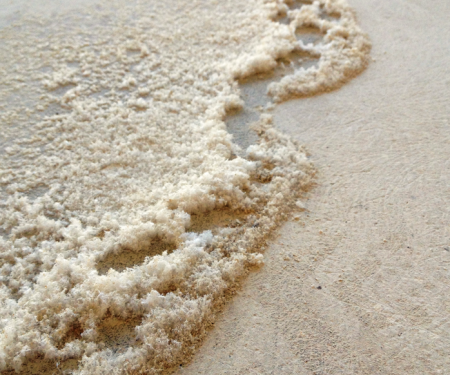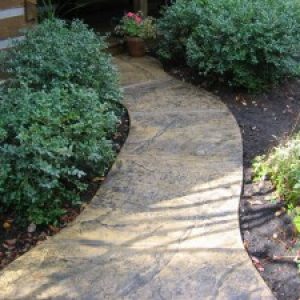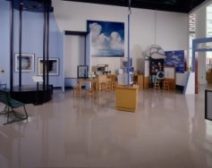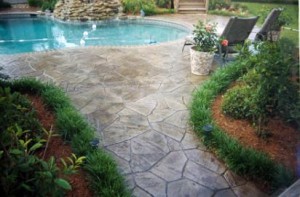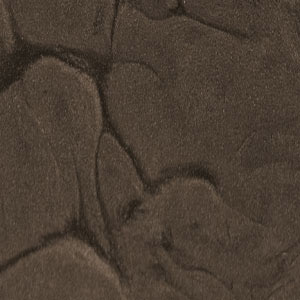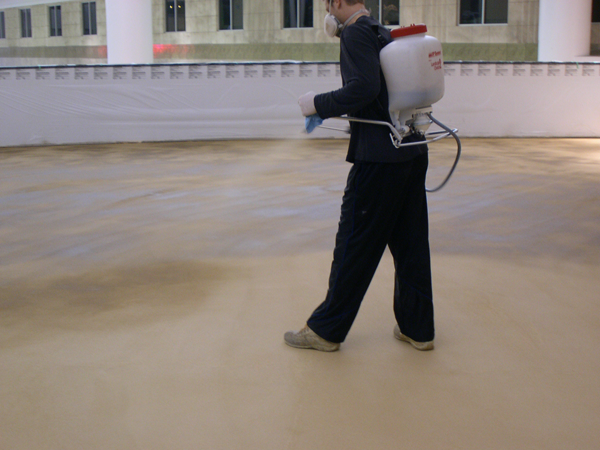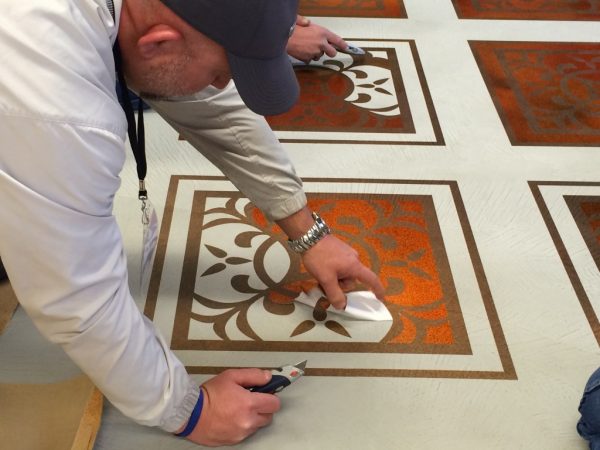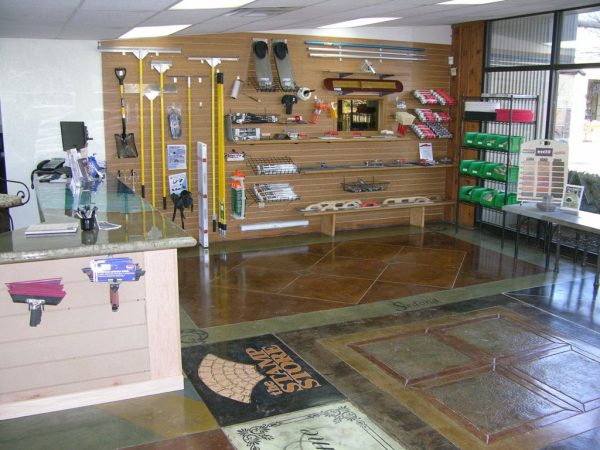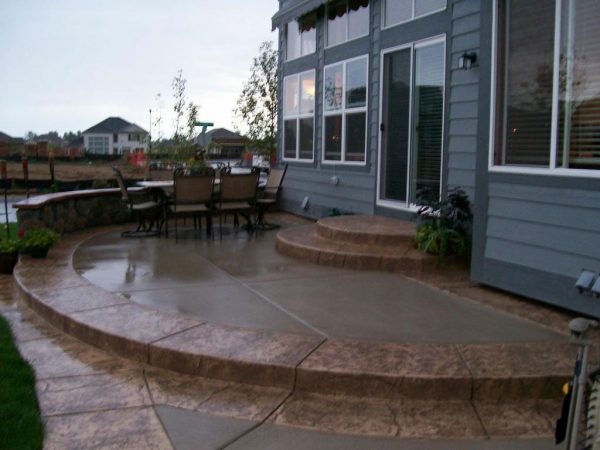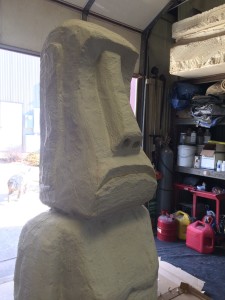Guide To Efflorescence
Introduction And Purpose Of The Article
Efflorescence is a fact of life with most concrete. We are hearing more about efflorescence related issues because of the popularity of stained floors. As the trend to have exposed concrete floors grows the industry is struggling with the problem of unsightly efflorescence, especially when it is trapped under a film forming sealer. This is not to say that exterior decorative concrete is immune from efflorescence issues, but problems with interior floors pose a greater challenge and are the focus of this discussion.
This article is meant to be a common sense overview of the major efflorescence issues. We will suggest realistic preventative measures to control the conditions that encourage efflorescence and we will offer remedial suggestions. We will offer useful explanations of this complex phenomenon in practical terms without a lengthy detailed chemical analysis.
Decorative contractors usually get the first phone call when efflorescence shows up on a stained floor. Many things may have contributed to a particular efflorescence plagued project, the least of which may be the work performed by the stain contractor who in most cases is unaware of the preexisting conditions that caused the efflorescence. la ivermectina la puede tomar un diabetico Stain contractors, concrete finishers, builders, general contractors, the design community and owners are all affected by issues related to efflorescence. We hope this discussion clarifies some of the issues so that efflorescence is better understood and the appropriate measures are taken to prevent its occurrence. The costs associated with efflorescence prevention are minimal when compared to the cost and inconvenience of the remedies, especially when the space is occupied. Efflorescence in itself is not a health problem although it might indicates moisture levels sufficient to support mold. Efflorescence is not a structural issue. It is an aesthetic issue, an issue we would all like to avoid. is ivermectin toxicity reversible?
Definition
Efflorescence is the white powdery substance on the surfaces of unsealed concrete and the white blush seen with sealed floors. Efflorescence is caused by vapor migrating through the slab bringing soluble salts to the surface of the concrete. Efflorescence is normally worn off or washed away on unsealed concrete surfaces. In stubborn cases, a mild acid rinse or even a light sandblasting may be necessary. Efflorescence that becomes trapped under sealer is unsightly and is even more conspicuous on darker floors. In worse case scenarios where the vapor cannot pass through the top coat, a urethane and/or an epoxy for instance, hydrostatic pressure can build to create water blisters indicating delamination of the top coat from the concrete. Blistering is rarely seen with acrylics. Acrylic sealers allow the vapor to pass through, but the salt deposits remain behind creating the unsightly blush that prompts owners to call the stain contractor.
Contributing Factors
Efflorescence requires the movement of moisture. Without moisture movement there would be no efflorescence on the surface to create the problem. Unfortunately, too many finishers (non-ACI Certified Finishers) routinely introduce large amounts of unnecessary “water of convenience” to the mix in order to facilitate concrete placement. Primary efflorescence is caused by the water in the concrete evaporating from the slab leaving behind the soluble salts on the concrete surface. The fact that these salts are actually more soluble in colder temperatures coupled with increased bleed water in cold weather increases the likelihood of efflorescence showing up after winter concrete placement. Contributing further to efflorescence with cold weather pours is the use of calcium chloride to accelerate the set time. High slump concrete and the addition of calcium chloride are major contributors to efflorescence.
Secondary efflorescence is often described as water coming from underneath the slab or water that is introduced from the surface. Likely sources of secondary efflorescence would be a saturated base material, an improperly drained site or excessive amounts of water used by the stain floor contractor during his cleaning process – rinsing off the acid stain residue, for example. When extra mix water and extra soluble salts from calcium chloride are added to concrete placed in cool weather followed by more water from the decorative processes, some degree of efflorescing is bound to occur.
Answers to the following questions would provide some insight into whether a job is a likely efflorescence problem waiting to happen. Are there signs of efflorescence now? Is the property properly drained? Does surface water run towards the foundation? Is there a French drain system? How old is the slab, what time of year was it poured? Was the concrete placed on a saturated sub grade? Was the concrete placed directly on a vapor retarder? Was a granular material placed over the vapor retarder (vapor barrier being the outdated term) and was the base saturated? If a vapor retarder was used, was it carefully taped at penetrations, around the plumbing, for instance? Did the mix design include fly ash? Was a waterproofing admixture used? Was calcium chloride used? How much “water of convenience” was added to the concrete? Was a curing compound or liquid densifier applied? Answers to at least some of these questions can give a stain contractor a heads up before wading into a project completely uninformed and unprepared.
Testing For Vapor Transmission
Even if some answers are provided it behooves the contractor to do some independent fact finding to determine the current vapor transmission rate (VTR). Probably the oldest test method is the Plastic Sheet Test (ASTM-D-4263) which is taping down a clear 18” X 18” sheet of poly and checking 72 hours later for condensation or for a darkened concrete surface. Both are indications of vapor transmission. Another surface moisture test is The Calcium Chloride Test which quantifies the rate of vapor transmission. This is a covered dish that is weighed before and after a twenty four hour period. Both are cost effective measures in determining whether vapor is active.
A note of caution when using these testing methods…the plastic sheet and chloride tests will track moisture movement near the top only. When the atmospheric conditions are similar to the slab conditions the tests might not indicate significant vapor transmission because movement happens when the ambient conditions differ from the slab conditions. Moisture migrates and moves toward cool temperatures. Vapor emissions migrate and move toward heat. Imagine the consequences of the following unpleasant, but very real scenario… the project is completed, the contractor has been paid, the delighted owner takes possession and turns on the HVAC causing vapor in the slab to move towards the warmth or the lower humidity of the conditioned space bringing the whitish minerals with it. If the sealer is acrylic the vapor will pass through leaving the efflorescence. If urethanes or epoxies are on the floor, hydrostatic pressure may build and possibly cause delamination. Efflorescence can occur months or even years after the contractor has left the job due to circumstances similar to those just described or from seasonal ground water seeping under the slab. Testing the surface may not be enough to guarantee an efflorescence free project for years to come. These tests provide “snapshot in time” information. It is important to determine how saturated the slab is and the source and the rate of vapor transmission before prescribing a remedy.
More real time technology comes with instruments like the Wagner Rapid RH (around $400) which gives an accurate reading of humidity below the surface of the slab and the temperature. Visit www. wagnermeters.com for even more moisture testing devices. The benefit of these tools is their accuracy in measuring the moisture levels well beneath the surface whether there is any current movement or not. Given the financial risk, not to mention damage to a contractor’s reputation it makes sense for a contractor to explore procedures that more clearly indicate subsurface conditions in order to avoid the efflorescence problems caused by moisture.
We mentioned that a well drained site and a vapor retarder are deterrents to efflorescence. The case can be made for placing the concrete directly on the vapor retarder or over granular material on top of the vapor retarder. The argument against the granular material is that it may become a saturated “blotter” before the slab is poured adding even more water that has only one way to leave—up. Finishers argue that there will be too much bleed water resulting in dusting, but a 3 or 4” slump concrete batched with water reducers and a well graded aggregate will show very little bleed water. The really important factor here is minimizing water in all the important areas—the sub grade, the concrete itself and the procedures performed by the stain contractor. The first two require some amount of water, but keeping water to a minimum helps ensure that efflorescence is controllable. More on coloring options a bit later.
To give an idea how much water may be available to bring soluble salts to the surface when these factors are not given any consideration let us consider a typical residential slab pour…assume we have a 2” thick blotter course of sand residing between the concrete slab and a vapor retarder. Dry sand weighs approximately 100 pounds per cubic foot. Wetted to achieve compaction, this sand could easily contain 10% moisture by weight, or 10 pounds of water per cubic foot of sand. It will take approximately 167 cubic feet of sand to cover 1,000 square feet of vapor retarder. That figures out to each 1,000 square feet of concrete surface having 1,670 pounds, or 200 gallons of water sitting on the underside of the slab with no where to go but up! Add that amount of water to another 60 or 70 extra gallons of “water of convenience” added by the slab finishers and we may have 270 gallons of extra water moving towards the surface whenever surface conditions are warmer or drier than the slab itself. There is another aspect of this foreboding picture… all this water and its eventual evaporation creates a void matrix that resembles a sponge with large pores and capillaries throughout the matrix, able to wick moisture up and quite willing to act as a hard sponge, capable of absorbing hundreds of pound of water from underneath the slab as well as any rain water or water used by the stain contractor in staining process on the surface.
Imagine the consequences of a fast track project (restaurants have to be the worst) with an acid stained floor on a slab as we just described, a few months old poured late in the year. The grand opening is early spring. The stain contractor, being the sincere person he or she is, has proposed an upgrade from the acrylic sealer in the specifications to an epoxy or urethane because of the heavy foot traffic. The suggestion was approved, epoxy coating it is. Our contractor goes into the project without a clue about the sub grade conditions, vapor retarder, mix design, admixtures, etc. There is one more complication all too familiar to staining contractors—the schedule. The superintendent greets our contractor on Monday with the news that the floor needs to be serviceable Friday morning so that the kitchen stoves and ovens can be dragged in over the weekend. Our contractor feels a bit overwhelmed, but plans the work: clean up the drywall mud today; stains tonight; cleans the residue Tuesday, apply epoxy Wednesday, Thursday is cure day, Friday is open for light traffic. This seems workable, life is good. No matter that the heat is not yet on in the building and the floor is not fully cured out. Our contractor, by the way, does not have walk behind floor scrubbers. Mops and buckets make up the clean up and water removal equipment (more than with a scrubber). This is not an uncommon set of circumstances. What do you suppose the chances are that the stained and coated floor will escape with no efflorescence?
Proactive Measures
Efflorescence reducing measures are: site surface drainage; a well graded concrete mix with a water reducer to minimize paste; concrete not exceeding a 4” slump; that the concrete be well consolidated (one man vibratory screeds do a great job); placed directly on a vapor retarder and cured in some fashion. All these factors contribute to a concrete that has a minimum amount of bleed water resulting in fewer pores and capillaries that will resist rather than facilitate absorption and movement of moisture… in other words, a dense and relatively impermeable concrete slab.
Now for more specifics…an option to the vapor retarder is a waterproofing admixture to help prevent efflorescence. This is added to the concrete at the plant, but it has a downside. It can pose real problems for the stain contractor since a common ingredient, stearic acid, is hydrophobic in the same way that powdered release agents for stamped concrete are so the waterproofed concrete does not readily accept either acid stains or water base stains. Suggestions in this case would be to open the surface with a sanding screen or a gelled acid to create some degree of profile enabling a better mechanical bond for the water borne stain and eventual sealer or coating.
Water borne stains do not require rinsing; there is no residue (SS Rainbow). Dye stains SS DYE-namic) also do not require rinsing. Each can deliver acid stain- like translucence and mottling when applied by experienced persons.
Helpful mix design factors include ordering a well graded a mix from the ready mix producer. The advantage gained from a well graded mix design is the reduction of the weakest part of concrete, the cement paste (cement and water), making for a denser concrete than with a standard mix. Another important mix design consideration is the replacement of 15% to 20% of the Portland cement with fly ash which contributes significantly to lessening efflorescence. Fly ash brings three important benefits to reducing efflorescence. Fly ash reduces the amount of Portland cement and free lime as well as chemically binding up a portion of the free lime and salts that cause efflorescence. In addition, fly ash requires less water again resulting in a denser paste which aids in keeping moisture from traveling up from the bottom and from the top down. Water reducers of course, are also helpful at minimizing the amount of water and a reduction of cement (paste). The closer a mix design gets to the desired water cement ratio of .45 pounds of water to pounds of cement, the fewer efflorescence issues arise, especially with a mix including fly ash. And forget the old notion that you can’t use integral color with fly ash, you can. Keeping multiple pours consistent with the mix design, sub grade conditions and finishing practices will produce consistent results. Heads up on this one… cold concrete and cold ambient temperatures encourage efflorescence because the salts are actually more soluble in colder temperatures plus concrete tends to bleed more in cooler weather further encouraging the upward transportation of moisture and its passenger, soluble salts. Follow ACI 306 Cold-Weather Concreting procedures whenever possible including raising the placement temperature of the concrete to 60 degrees and then cover overnight to retain the heat. This will encourage a more dense pore and capillary structure and help close down the moisture transportation routes.
Curing becomes important as we recognize that moisture moves much more slowly through denser concrete from either direction. cuantas gotas se toma la ivermectina When concrete is kept moist for a longer period, especially the first few days, more capillaries and pores fill partially or completely to form a denser and more impermeable matrix that discourages the migration of moisture and soluble salts. Conversely concrete that is placed at a high slump and not cured acts as a sponge, full of miniature raceways allowing easy movement of moisture from the bottom up and top down. Cure and seal membrane type cures poses a problem in that the membrane has to be removed to accept acid stains, so they are not often used. One manufacturer has a thermal degrading wax that breaks down with hot water. Water borne stains (SS Rainbow) are becoming popular and manufacturers are working to formulate compatible curing membranes that will accept subsequent staining. Dye stains like (SS DYE- namic) use no water at all and come in many colors. Wet curing is difficult because it must be continuous and may create discoloration if a plastic sheet has wrinkles.
What Tools Are Available?
Technology that might offer double relief from efflorescence related issues involves the use of chemical liquid densifiers and hardeners. First, manufacturers say chemically hardened floors do not require a membrane sealer. This eliminates the trapped efflorescence problem and also greatly reduces maintenance costs. The chemicals include silicates, silicaonates, polysiliconates, silanes, siloxanes and the new lithiums, to name a few. Some of these are used in conjunction with polished concrete floors. Some are used on floors already acid stained or dye stained and could receive a membrane type sealer. Some of these chemicals have been used for years and some are relatively new to market. Claims vary from product to product and from manufacturer about how far the chemicals penetrate, their permanence and the levels of shine and slip resistance. We know for certain that the big box stores are getting away from vinyl and going to bare concrete. Decorative floor contractors would be well served to explore this technology even for smaller residential stained floors. Secondly, some contractors are following the application of acid stains with silicate type non-film forming sealers generically described as chemical hardeners, densifiers and soluble chloride reducers within a few days of concrete placement (SS Densifier). Efflorescence is reduced as the silicate causes the matrix to become denser as we described earlier. The contractor has the option of adding conventional membrane forming sealers if subsequent VTR tests indicate acceptable levels or may apply a guard (SS Polishing Guard) with possible sacrificial wax (SS Cherry Wax available in Gloss or Matte options).
What To Do When Efflorescence Shows Up Under The Sealer
What are the options when efflorescence rears its ugly head? A fast fix might be to use xylol, xylene or another coat of solvent base acrylic which reemulsifies the original sealer and clears the blush. If vapor continues to come up through the slab though, the condition will most likely reappear. Be aware that if the space is occupied there can be health issues because of solvents like xylene.
The most prudent course of action includes stripping the sealer in order to conduct a test to determine the rate of vapor transfer and then develop a remedial strategy. Soy Gel is a reliable “green” stripper. It is important to get it right the second time so take time to diagnosis the causes as best you can with the information available. One of the more expensive hand held digital instruments may prove to be a valuable tool because they are able to get accurate moisture reading below the surface of the slab. Once the moisture levels are established a sealer can chosen based upon the manufacturer’s recommendations.
Remember that some manufacturers have the vapor inhibiting, non-film forming sealers that we mentioned earlier. These may reduce the vapor transmission rate to a level appropriate for a heavier bodied more abrasion resistant top coat for use in high foot traffic situations. (CP 1007)
Where slabs have continued to have efflorescence problems even after the application of a lithium or silicate densifier contractors have used a finish or polish, which are industrial grade “mop and glow” – low build, low solids micronized acrylic water based products as the final treatment. These finishes and polishes can also be used over film forming sealers to for additional abrasion resistance.
In most efflorescence cases, the stain contractor inherited the problems that contributed to creating the efflorescence. Diagnosing the causes of efflorescence after the floor has been sealed can be difficult. It is important to determine how much moisture exists in the slab, the source of the moisture and also whether conditions, like seasonal ground water might contribute more moisture in the future. Consider vapor testing and resist the quick fix. Finally, contractors may elect to avoid warranty language where sealers are concerned or they may choose to specifically define typical vapor transmission problems. The decorative adage of “test, test, and test” holds especially true for interior stained floors. It means doing a VTR test whenever you suspect there may be the potential for efflorescence problems. Happy staining and remember—education is not expensive considering the cost of “call backs” and you don’t have to take every job that comes your way.
Written by Doug Bannister, concrete enthusiast since the beginning of time.
Is Your Driveway and Walkway Contributing To Your Homes Curb Appeal Or Hindering It?
If the answer is ‘contributing’ to curb appeal, then you probably already rock it with decorative concrete and you should know that #WeLoveConcrete. But if the answer is ‘hindering’, then know that decorative concrete is a great way to fix those issues.
Maybe your driveway is cracked and uneven and even (gasp) just gray. Have you priced tear out and replacement? Yikes, it’s expensive and it sure seems like a waste in the landfills. An alternative is an overlay. This thin layer of new concrete is a great way to have a new pallet to work with. Now, you can’t just skim a new layer of concrete over the old messed up slab…you do need to do some repairs and even prepare the substrate properly. Skipping this critical step will be the cause of an overlay delamination and failure.
There are a variety of overlays to choose from for your driveway and walkways to increase your curb appeal and add value to your home:
Microtoppings
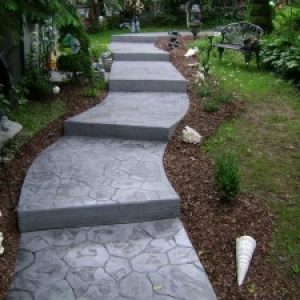 The cement-based microtoppings such as SS Spray Base can be used outdoors to provide a clean canvas for decorative treatments, such as Sedona Acid Stains, dyes and stenciled patterns. Iron oxide pigments can be added which provide a range of colors, while others can be custom tinted by mixing in the desired amount of liquid coloring agent. Interesting color variations can be achieved by applying layers of different hues.
The cement-based microtoppings such as SS Spray Base can be used outdoors to provide a clean canvas for decorative treatments, such as Sedona Acid Stains, dyes and stenciled patterns. Iron oxide pigments can be added which provide a range of colors, while others can be custom tinted by mixing in the desired amount of liquid coloring agent. Interesting color variations can be achieved by applying layers of different hues.
Spray Knock-down Toppings
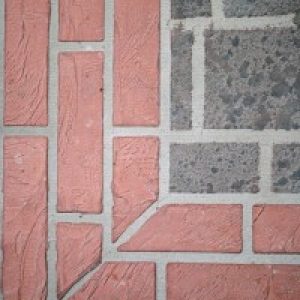 Versatile and easy to apply, spray-knock down concrete systems offer a wide array of finish options all of which add tremendous curb appeal. Usually they are sprayed evenly onto concrete with a hopper gun, but they can also be applied as a splatter coat to create a textured, slip-resistant surface or “knocked down” with a trowel to create a smoother finish. They are very similar to microtoppings in that they are thin, but differ in that they usually contain more sand and provide a rougher, grittier finish.
Versatile and easy to apply, spray-knock down concrete systems offer a wide array of finish options all of which add tremendous curb appeal. Usually they are sprayed evenly onto concrete with a hopper gun, but they can also be applied as a splatter coat to create a textured, slip-resistant surface or “knocked down” with a trowel to create a smoother finish. They are very similar to microtoppings in that they are thin, but differ in that they usually contain more sand and provide a rougher, grittier finish.
Stamped Concrete Overlays
A stamped overlay offers all the aesthetic benefits of conventional stamped concrete but is applied over existing concrete. Stamped concrete overlays allow you to duplicate the beauty and texture of natural stone, brick, slate, wood, and other materials without having to replace your concrete.
Need ideas? Need Help?
You can see from the different systems that you can do A LOT to improve your outdoor curb appeal. We really encourage you to stop by Moon Decorative and take a look at our 30,000 square feet of all types of decorative concrete. Our knowledgeable staff can help sort out the details and answer your questions. We even have a helpful list of contractors that can come out and do the actual work. Often times, they even have great ideas and suggestions as well.
How To Put The Shine On Your Concrete Floors
Is your concrete floor looking dull and dingy? Needing a little shiny pick-me-up?
SS Cherry Wax may be exactly what you need.
SS Cherry Wax acts as a sacrificial coating to protect the longevity of your sealer. Plus it gives a great shine, thus looking like you just got a brand new floor!
How to apply?
Talk about easy….start with a clean floor. ie, no dirt, or grime. In other words, sweep your floor (maybe even mop it with water), start with a clean palate. Remember the ole’ Mop & Glo? Good, because all you do is pour out about a plate sized portion on the floor, get your mop and start spreading. Easy! It dries in about 30 to 45 minutes or less and leaves a beautiful shine. One key you need to keep in mind is to use the right kind of mop….needs to be a lambs wool applicator or a synthetic mop head. Don’t use cotton, it will just absorb all the Cherry Wax and be wasteful.
For larger commercial jobs, Cherry Wax can be applied with a high speed burnisher.
How long will it last?
High traffic areas, (kids, dogs, and dirt) will need more frequent applications than those areas that only grandma scoots around in her slippers. When do you know its time to reapply? When you would like to make it look new again….it’s time!
Environmentally friendly
SS Cherry Wax is non-flammable, non-combustible, non-corrosive and completely non-hazardous! It’s great smelling cherry scent is very pleasing to the nose. It contains only environmentally safe materials, and provides quality high sheen and resistance to abrasion and scuffing. Don’t like the shine? Don’t worry just get the matte finish.
Need some?
You can pick up a gallon bottle off the shelf at Moon Decorative. Or you can order on line. We’d encourage you to come in to see our store, meet our knowledgeable staff and look around. With over 30,000 square feet of ideas and enough decorative concrete delight, you will be inspired to think beyond gray boring concrete.
Taking Your Project to the Next Level with Specialty Concrete Products
Whether you are a licensed contractor or a DIY homeowner, specialty concrete products are the key to making your next project a success. Decorative concrete is one of the most versatile and customizable building materials out there so there is sure to be a product that is suited to your particular project. كاس امم اوروبا 2024 To learn more about specialty concrete products, contact Moon Decorative.
Using Specialty Concrete Products
Specialty concrete products come in a variety of forms, including everything from concrete stamps and stains to epoxy flooring and textured sealers. Because these products are so widely varied, you can find a product to suit any project you have in mind. Below you will find an overview of some of the top specialty concrete products:
- Decorative Concrete Overlays – If you want to create new flooring or upgrade an existing floor, decorative concrete overlays are a great way to go. You can use these specialty concrete products to give your flooring the look and feel of premium materials without the hassle of installation.
- Epoxy Floor Coatings – This type of coating is ideal for indoor flooring in residential applications as well as commercial and industrial applications. Epoxy floor coatings, such as SS Aliphatic 100% Epoxy, are highly durable, and they can be used to protect and seal your flooring against foot traffic, chemical spills, and normal wear-and-tear.
- Concrete Stains and Dyes – These specialty concrete products are a great way to customize decorative concrete. Stains and dyes can be used to add color and pattern to your flooring. ألعاب كازينو
- Concrete Countertop Mix – Concrete can be used to make custom countertops as well as flooring. In fact, concrete countertop mixes are specially designed for use by contractors and DIY homeowners for custom counters.
- Concrete Sealer – After you apply a specialty concrete product, you’ll want to protect it with a concrete sealer. These come in a variety of forms, so choose the one that best suits your project. طاولة على النت
Success Tips for Working with Metallic Epoxy
If you are looking for a way to make your flooring stand out, you might want to consider a metallic epoxy floor coating. Not only are metallic epoxy coatings unique and eye-catching, but they can add durability to your flooring as well. can i give my dog benadryl while treating for mange with ivermectin
Tips for Using Metallic Epoxy
Metallic epoxy coatings can be applied over existing surfaces as long as you prepare the surface properly. Surface preparation starts with cleaning the entire surface as well as patching and repairing any cracks and chips. In some cases, it may also be necessary to grind the surface to correct uneven areas or to remove stubborn stains and residues. ivermectin use in hindi myupchar Once the surface has been prepared, you can go through the steps to apply the epoxy coating.
First, you’ll need to prime the surface using either a solvent- or a water-based epoxy primer. Next, you will apply the metallic colored base coat over the entire surface – this will serve as the background for your coating. Once the base coat has been applied, you then mix the powdered SS Metallic pigment into your epoxy coating mix and apply it as desired to create a unique metallic pattern. After you’ve finished the metallic epoxy application, all that is left is to protect the surface with a clear topcoat. This topcoat will help to seal in the color and pattern while also increasing durability and abrasion-resistance. It will also help to give your new metallic epoxy flooring a lovely shine.
If you are thinking about using epoxy to update or upgrade your flooring, you can trust Moon Decorative to have all of the products you need. Whether you are a concrete contractor or you are planning to do the work yourself, make Moon Decorative your first stop – just call today or visit our website. ivermectin frontline
Working with a Concrete Sealer Sprayer
Finishing your surface with a layer of concrete sealer is a must if you want your new surface to look great and to last a lifetime. Applying clear sealer is not necessarily a difficult task, but you do need a special concrete sealer sprayer, and there are some tips you should follow. legjobb kaszinó online When you are ready to buy a concrete sealer sprayer, be sure to make Moon Decorative your first stop.
Tips for Using a Concrete Sealer Sprayer
After you’ve finished applying your new flooring or your preferred decorative concrete product, you may think that you are done. It is important to remember, however, that you still have one more step – sealing the surface to protect it against foot traffic and, for outdoor surfaces, the elements and various environmental pollutants. When you are ready to apply your sealer, follow these tips for using a concrete sealer sprayer:
- Choose the right type of sprayer for the job. A hand pump sprayer is ideal for water-based sealers and for small surface areas. A low-pressure high-volume sprayer, such as the Chapin Acid Staining Sprayer, can be used with any sealer type, and it creates professional-looking finishes. Rollers can also be used to apply sealer, but a sprayer will do a better job.
- Select the right type of sealer for the job – your main options are water-based sealer and solvent-based sealer. Some sealers are designed primarily for indoor use while others are good for outdoor applications. Different sealers also offer different finishes (like high-gloss versus matte), and some can be customized with aggregates to add texture.
- When working with water-based sealers, apply the sealer in multiple thin coats – follow the directions on the sealer to determine how much time you need to give the sealer to dry between coats. gaminator bónusz kódok 2021
- If you choose to use a solvent-based sealer, you should apply it using a sprayer and then follow up the spray with a back roll – this helps to ensure more consistent coverage. One simple way to do this is to dilute the first coat and apply it with a roller, then apply the second coat in the opposite direction.
You can spend hours, even days, installing beautiful decorative concrete overlay or new flooring. But it could all be for naught if you fail to protect the surface with the right sealer. When you are ready to apply the final touches to your surface, make sure to invest in a quality concrete sealer sprayer so you can get the job done right. élő tippmix
What You Need to Know to Get Started with Decorative Cement
If you are thinking about remodeling your home or simply upgrading your existing flooring, decorative cement is a great way to go. Decorative cement is a highly versatile option, and it can be customized with an unlimited array of options for color, pattern, design, and texture. If you are thinking about using decorative cement, take a moment to learn the basics.
Tips for Using Decorative Cement
The first thing you need to know about decorative concrete is that it comes in many forms, and it can be customized in any way you like by combining multiple products together. For example, you can use a decorative cement overlay to create a smooth surface and then treat it with a stain or dye to add color. You can also give your new flooring texture by adding some kind of aggregate, such as sand, to enhance the slip resistance of the surface. is ivermectin toxic to dachshunds
When using decorative cement products, you’ll need to prepare your surface prior to the application. how much ivermectin paste to take This may involve patching cracks, smoothing uneven areas, and grinding the surface to improve adhesion. When you are ready to apply your decorative concrete, it is a good idea to do all of it at once – this will help to ensure consistency in color and pattern. drontol vs ivermectin for dogs Once the cement has been laid, you can then customize it using your choice of stains, dyes, sealers, and topcoats. You are only limited by the confines of your own imagination, so don’t be afraid to get creative!
No matter what kind of project you have in mind, be sure to make Moon Decorative your first stop for decorative cement products. We are one of the nation’s leading concrete dealers, so you can bet that you will find everything you need. Simply visit our website or call today for more information.
Must-Have Concrete Floor Supplies
The beauty of decorative concrete is that it is a highly versatile and customizable building material. Simply put, you can use concrete to create the look and feel of premium materials, and you can customize your flooring in an endless array of styles. If you are thinking about using decorative concrete for your next project, be sure to call Moon Decorative for all your concrete floor supplies.
Popular Concrete Floor Supplies
When it comes to applying new concrete flooring – or even if you are just upgrading an existing slab – you will need a few particular concrete floor supplies. You’ll find an overview of popular concrete floor supplies below:
- Concrete Stamps – If you want to give your concrete flooring the look of premium building materials (like natural stone, pavers, or brick), then you will need a stamp. Stamped concrete is applied by putting down a thin layer of concrete and then stamping it with the desired pattern.
- Stains and Dyes – Concrete stains and dyes are a great way to add color to concrete flooring. Acid stains can give your concrete a mottled appearance in a variety of natural earth tones while dyes and water-based stains can be used to create an unlimited range of colors and patterns.
- Concrete Sealer – After you do the work to install your new concrete flooring, you want to make sure that it will last for as long as possible. Concrete sealer is the key to increasing the durability and longevity of your flooring; plus, it can enhance the appearance with color or shine. There are a number of types of sealers, so choose the one that is best for your particular project.
- Sealer Sprayer – In order to use the concrete sealer of your choice, you will need a concrete sealer sprayer. These sprayers come in a variety of forms, including hand pumps and low-pressure high-volume sprayers. Some sprayers are easier to use than others, and some offer greater consistency. At Moon Decorative, we offer sprayers from such brands as B&G, Chapin, and Toolcrete.
- Rollers and Accessories – Another method for applying concrete sealer and various other projects is with a roller. If you plan to use SS Metallic epoxy or a concrete stain, you’ll need a roller to make the application once you’ve chosen your product.
Whether you are installing new concrete flooring or upgrading you existing flooring, there are certain concrete floor supplies that you are definitely going to need. Fortunately, Moon Decorative is always on-call to provide for your needs. Simply give us a call or visit our website for more information.
Should You Choose Concrete Stamping or Staining?
Is concrete stamping or staining best for your upcoming project? Both stamping and staining present a number of benefits, but which option is best will depend on your specific needs and the look you wish to achieve. dosis de quanox locion para niños
Concrete Stamping
Concrete stamping offers an array of design options. In fact, with this decorative concrete option, it’s possible to create virtually any look you might desire. You can even mimic the look of natural stone by using the correct stamping tools. Stamped concrete also offers the benefit of ease of installation. Installing stamped concrete is far less labor intensive than other options, including the installation of individual stones or pavers. All that is required to install stamped concrete is mixing the concrete, pouring it, and stamping it. While stamped concrete does offer many advantages, there are also drawbacks to consider. dosis quanox gotas adultos For instance, it is important to take care where and how stamped concrete is installed, as it may not hold up well to heavy loads if it is simply for a decorative function, and could be susceptible to cracking when placed under a heavy load like a dump truck full of a heavy weight load.
Concrete Staining
Concrete staining also presents a number of important benefits, including the fact that the acid can be added to existing concrete slabs. Adding acid stain, such as Sedona Acid Stain, to your existing concrete floors can help improve the look of your floor and if sealed correctly can make it more stain resistant as well as easier to maintain. All that is required to maintain a stained concrete floor is a simple wash with some soapy water. There are some disadvantages to stained concrete to take into consideration. Among those drawbacks is the fact that there are not as many design options available with stained concrete as with other options, including stamped concrete. birds ivermectin dogs
The choice of whether stained or stamped concrete is the right choice for your design needs is highly personal. Understanding the advantages and disadvantages of both can help you make a more informed decision.
Moai has arrived at Moon Decorative’s Concrete Art Garden
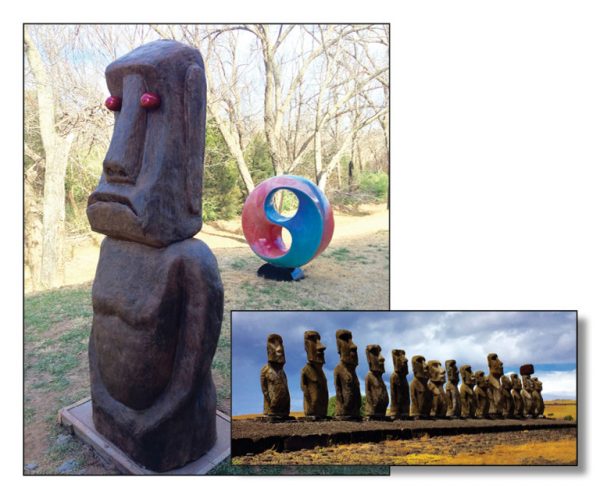
Easter Island covers roughly 64 square miles in the South Pacific Ocean, and is located some 2,300 miles from Chile’s west coast and 2,500 miles east of Tahiti. Known as Rapa Nui to its earliest inhabitants, the island was christened Paaseiland, or Easter Island, by Dutch explorers in honor of the day of their arrival in 1722. It was annexed by Chile in the late 19th century and now maintains an economy based largely on tourism. Easter Island’s most dramatic claim to fame is an array of almost 900 giant stone figures that date back many centuries. The statues reveal their creators to be master craftsmen and engineers, and are distinctive among other stone sculptures found in Polynesian cultures.
There has been much speculation about the exact purpose of the statues, the role they played in the ancient civilization of Easter Island and the way they may have been constructed and transported. However, we know exactly how the SS Moai’s were constructed. Tim Frazier, Lead Trainer at Moon Decorative, started with a large piece of styrofoam and began cutting out the faces. After he got them like he wanted, he covered the figures with SS Concentrated Liquid Polymer and then SS Vertical Mix. The coloring was done with SS Vertical Color Dark Brown and Black.
These enormous stone busts–known as moai average 13 feet high, with a weight of 13 tons, were carved out of tuff (the light, porous rock formed by consolidated volcanic ash) and placed atop ceremonial stone platforms called ahus. It is still unknown precisely why these statues were constructed in such numbers and on such a scale, or how they were moved around the island.
